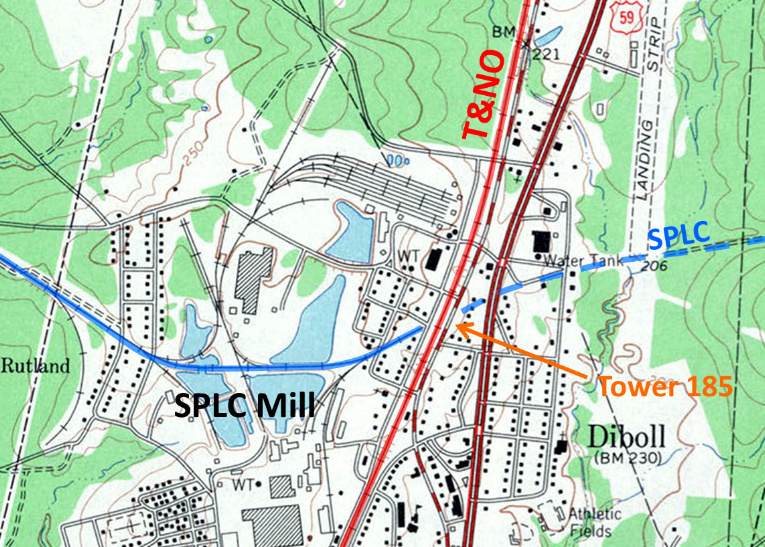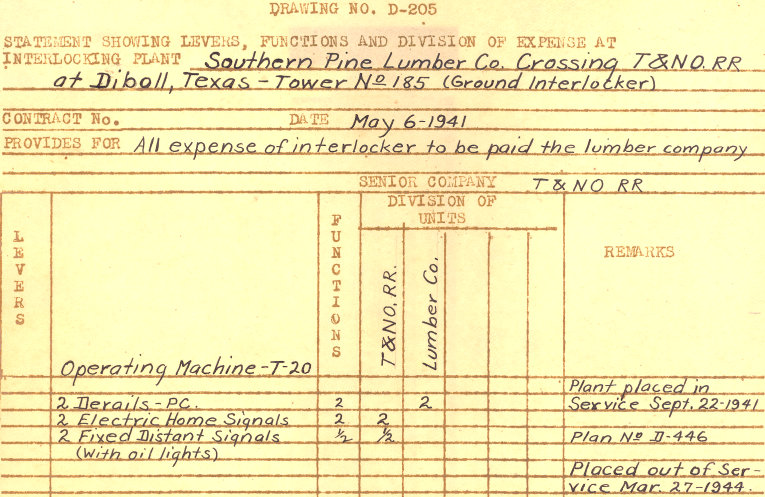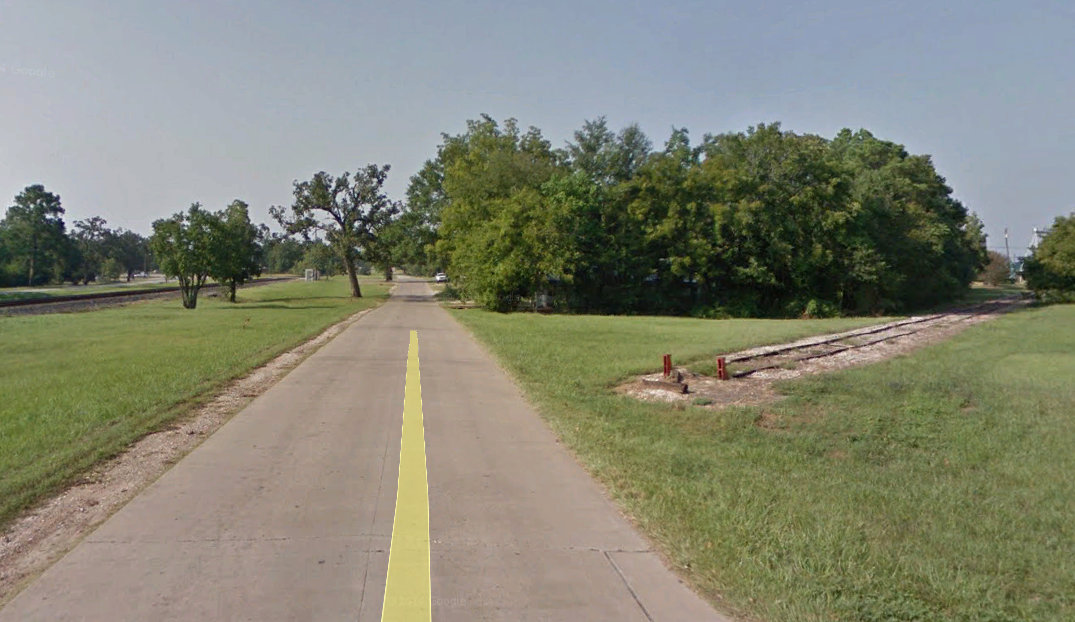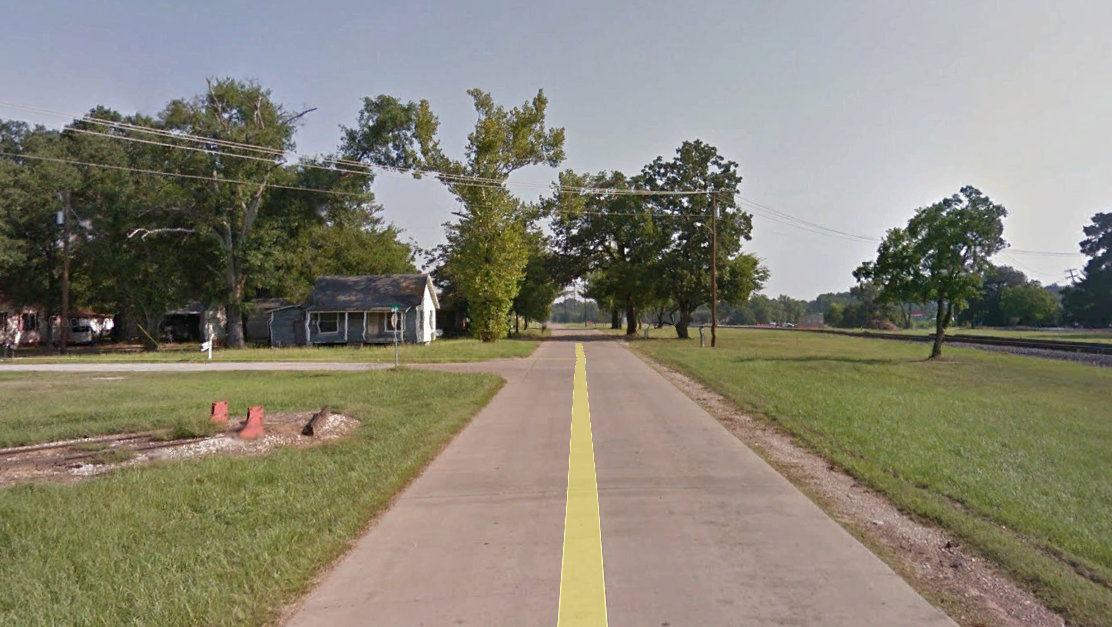Texas Railroad History - Tower 185 - Diboll
A Crossing of the Texas & New Orleans Railroad and the Southern Pine
Lumber Company

Above: This annotated 1963
USGS Topo map of Diboll shows the Southern Pine Lumber Co. (SPLC) mill located slightly
west of the Texas & New Orleans (T&NO) main line, in red. All other railroad tracks on the map
belong to SPLC; locomotives were used extensively in bringing logs to the
mill and moving them through the milling process. The dashed blue line shows
where an extension of a mill track crossed the T&NO main line at Tower 185
and continued northeast to Diboll Jct. on the Cotton Belt. Below: The SP
drawing details the "Levers, Functions and Division of Expense" at Tower 185.
The agreement shows that the lumber company paid all of the expenses for
maintenance of the interlocker. (Carl Codney collection)

The Houston East & West Texas (HE&WT) Railway began building a narrow gauge
line north out of Houston in 1877, eventually reaching Nacogdoches in 1882 and
the Louisiana state line in 1885. Unfortunately, the HE&WT was built as a narrow
gauge railroad which limited opportunities for exchanging traffic. The HE&WT
overcame this mistake by converting the entire line from Houston to Shreveport
to standard gauge on 29 July 1894. Five years later, Southern Pacific (SP)
bought the HE&WT but continued to operate it under that name. In 1927, the HE&WT
was leased to the Texas & New Orleans (T&NO) Railroad, SP's principal operating
subsidiary in Texas and Louisiana. In 1934, the HE&WT was fully merged into the
T&NO.
One of the major towns on the HE&WT was Lufkin, the county seat of Angelina.
Twelve miles south of Lufkin, the community of Diboll was founded in 1894 when
Thomas L. L. Temple built a sawmill adjacent to the the HE&WT. He named his new
concern the Southern Pine Lumber Company (SPLC). The company grew substantially
over many years and, with mergers, acquisitions and buyouts, became one of the
largest wood products companies in the U.S. The mill in Diboll remains active
today.
In 1900, T. L. L. Temple chartered the Texas Southeastern (TSE) Railroad to
expand rail service in and out of the SPLC mill in Diboll, with aspirations to
serve other mills in east Texas. One of the first TSE projects was to convert an
existing SPLC narrow gauge logging line to standard gauge. The line ran a short
distance east from the mill at Diboll, crossing the HE&WT in the middle of town.
TSE extended this line 15 miles northeast to a connection with the Cotton Belt
railroad near Homer, east of Lufkin, at a location named Diboll Junction. At the
time, the Cotton Belt was independent of SP, so TSE's connection to the Cotton
Belt provided competition for the HE&WT for outbound wood products from the mill at
Diboll. TSE expanded west from Diboll and added lines elsewhere in east Texas,
eventually operating more than 50 miles of track. TSE hauled logs to
mills, but also served sawmills by carrying outbound wood products and providing passenger
and mixed freight service.
In the 1920s, TSE operations changed. TSE began to focus on other aspects of
the lumber business and Southern Pine Lumber Co. locomotives
began hauling SPLC's raw logs directly to the Diboll mill (using TSE's tracks
where available.) In 1920, 98% of TSE's freight tonnage came from hauling wood
products, and 67% of this was logs. By the end of the decade, wood products was
down to 85% of TSE's freight tonnage, and 75% of this was lumber coming out of
the mills.
In 1939, the Cotton
Belt line out of Lufkin through Diboll Junction and east to Prestridge was
abandoned. It is likely that TSE operations between Diboll and Diboll Junction
had already ceased, but we have no confirmation of that. For whatever reasons,
the decision was made to interlock the SPLC
crossing of the HE&WT (now T&NO) at Diboll. According to a drawing obtained by Carl Codney from SP's Houston
office, Tower 185 was placed in service on 22 September 1941 to control the
crossing but it was short-lived; Tower 185 was decommissioned
on 27 March 1944.
The SP drawing describes Tower 185 as a "ground interlocker." This was
similar to a cabin interlocker except that the control was as simple as possible
-- a single lever located at ground level near the diamond. All lumber trains
approaching the crossing had to stop prior to reaching the derail. A train crew
member would throw the lever to the opposite position which would clear the
derails and cause the two home signals (i.e. in both directions) on the T&NO to
display a stop indication. When the lumber train had crossed and cleared the
second derail, the crew member would return the lever to its normal position.
This would reinstate the derails on the lumber tracks and assert "all clear"
signals on the T&NO, allowing their traffic to cross the diamond without delay.
The T&NO line continues to see heavy traffic through Diboll, now owned by
Union Pacific (UP), and UP serves the mill through a spur on the south side of
Diboll. It is apparent from satellite imagery that the mill continues to make
extensive use of locomotives and railcars.
Special Thanks to Jonathan Gerland, Executive Director of
The History Center in
Diboll for assistance in collecting information about Tower 185.
Google Street View imagery, Tower 185 Site

Above: Looking south,
the UP tracks are at left proceeding south in the distance through the center of
Diboll. At right, the former SPLC spur that crossed the T&NO at Tower 185
terminates but remains intact. Below: Looking north, the utility poles align
with the former SPLC track and proceed across the UP tracks. The pole at far
right is part of this alignment which demonstrates the former SPLC
right-of-way through the site of Tower 185. The interlocker lever would have been visible
near the diamond from this vantage point in the early 1940s.




